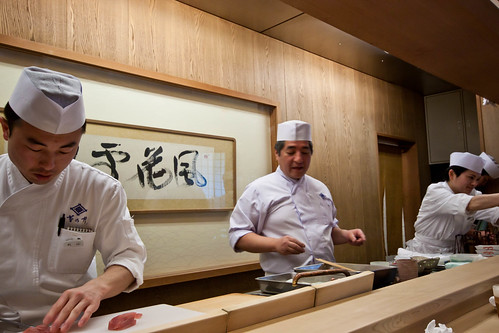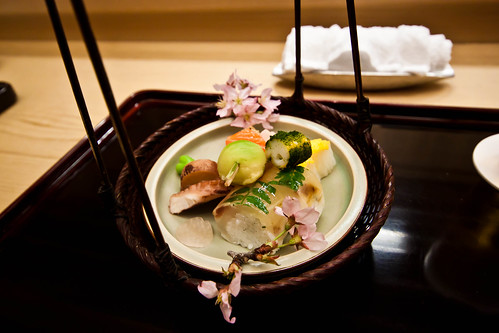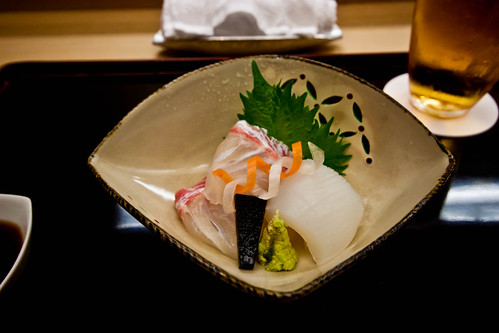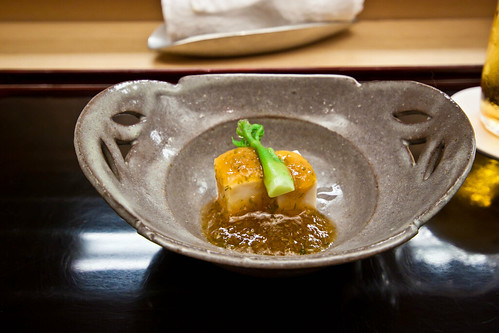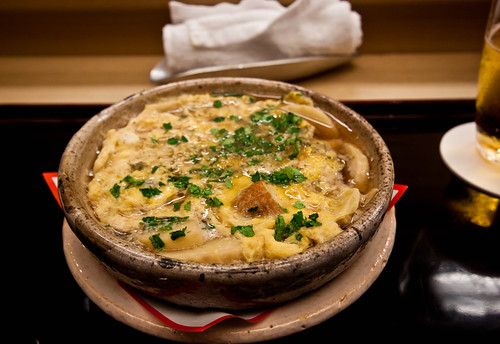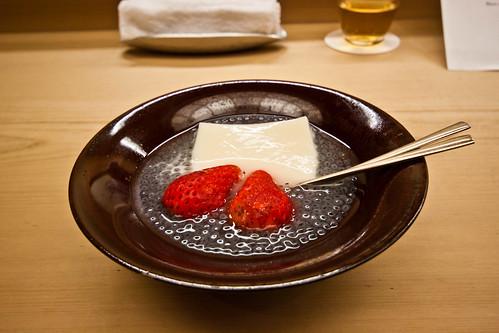“For whatever reason, modern Japanese have maintained their deep emotional linkage with the annual shifts in climate, ingrained from ancient times whether cultivating crops or fishing on the coast. So much is this connection the heart and soul of a cuisine, that when I am asked, “What is kaiseki?” I often have a very simple answer.
“It is eating the seasons.”
— Yoshihiro Murata, Kikunoi
Roan Kikunoi, according to the 2011 Michelin Guide for Kyoto, Osaka and Kobe, was created by Chef Murata as a somewhat more affordable option for the younger set as compared to Kikunoi Honten, his flagship fine-dining restaurant that’s garnered 3 Michelin stars. His other outpost in Akasaka, Tokyo, won 2 stars and admittedly Roan Kikunoi has 2 stars for itself. Though quite a high bar, lunch here is also possibly one of the best deals for sampling kaiseki in Kyoto. Chef Yoshimi Murata has been something of an international celebrity, recently receiving accolades from Noma’s Rene Redzepi (best meal), providing consulting advice to Singapore Airlines for in-flight meals and releasing a gorgeous English cookbook that garnered him a James Beard nomination. He also appears to somewhat controversial in Kyoto, as evidenced by this discussion string on Chowhound.
Towards the end of our stay in Kyoto DD and I had lunch at Roan Kikunoi, and definitely enjoyed its kappou-style counter dining where we could watch the chefs preparing and finishing dishes before our eyes. We made a last-minute reservation (3 days ahead) with the help of Chase Visa concierge – we were lucky enough to squeeze in an 11:30am reservation since they were fully booked that day.
A gorgeous starter, the hassun represents the April o-hanami season: cherry-blossom viewing. In the center of the fish is a skewer of miso-marinated avocado, fatty smoked salmon and a mousse of Tai liver. To the right is poached egg-bearing octopus (Iidako), a gorgeous jewel of a fava bean (Issun soramame); to the left of the tai liver is steamed Yurime lily bulb “petals” topped with ikura, and mountain yam (chocho nagaimo) “butterfly” covered with crumbled egg yolk. My dish initially came without the ikura atoo the yurime and DD took it upon himself to ask why my ikura was missing. Laughing, the staff promptly rectified the omission.
In this view you can see the Tai Kinome-zushi: vinegared Sea Bream sushi topped with kinome pepper leaf; in the upper right is broiled squid that is intended to resemble bracken fern, dusted with nori powder. We also had a tai-heavy menu at Kichisen, and so it was clear that Tai is popular in the spring in Kyoto. So popular and beloved is this fish that apparently it’s given different names, according to the season or month. In April, not surprisingly, it’s called sakura dai.
Tasty and simple, Tai has always been a favourite, and I do like its chewy texture. The squid was the star, however. The knifework on its surface was so fine and hair-thin that it rendered this beautiful piece of seafood uber-tender.
This was my favourite dish, if only for the amazing egg yolk sauce. Chef sliced the tuna thickly, and dabbed it with a mustard point that was almost uneccessary; the egg yolk sauce was the highlight of the dish. One of the staff spied me poking at the remaining sauce with my chopsticks, took pity, and provided spoons. I would have taken a finger to the bowl had we been alone. The cookbook notes that the egg yolks are marinated in tosa shoyu for about 2 days. Tosa shoyu is basically soy sauce enhanced (or mellowed) by that holy gang of Japanese flavour-imparting elements: bonito flakes, sake and mirin. Considering that the egg yolk sauce with toro is a Kikunoi signature dish – I was actually pretty surprised initially to find the recipe in Chef Murata’s cookbook. While helpful, he definitely gives nothing of his secrets away – the ingredient list calls for 4 egg yolks and tosa soy. The procedure: “Soak unbroken egg yolks in tosa soy sauce for 1-2 days. Whisk well to finish sauce.”
Guidance from the staff dictated that we lift the cover of a gorgeous bowl flecked with gold leaf and breathe in the sakura aroma. Chef takes thin slices of mild-tasting tilefish (Guji – in the cookbook Murato notes tilefish provides a blank canvas for chefs) and wraps them around sticky, steamed and crushed glutinous rice. He tops the guji and rice with salted cherry leaf and pours in a thickened dashi broth. This was a steaming-hot dish and I pretty much singed my tongue taking the first bite. However, the familiar flavours of smoky dashi and cherry blossom soon came through, and I was able to cool a hot palate with cold beer.
Delicious. The Tai milt (shirako) was creamy and mild, punctuated by sea-notes of sea cucumber roe (orangish covering on top) and the yuzu ponzu jelly.
Another steaming-hot dish. I had learned my lesson and waited a bit until trying it out. It reminded me a little of oyakodon but without the rice. The broth was also more savoury (not so much mirin, perhaps) and I thought that my dish could have used a bit more anago, which itself was very soft and sweet. This was the last primary dish of the meal; the rest consisted of the traditional pickles, rice, soup and tea.
From the left, Nanohana (rape blossom), lightly dressed with wasabi, something in the middle I can’t remember and what I believe was a marinated rare black mushroom.
As usual, our order included a lot of rice and they ended up giving us what was left to take home, similarly with Kichisen.
Soup of pureed green peas and dashi, thickened with kuzu starch. There was a dumpling in there as well, made of yamaimo, kameboko, and egg; steamed then fried. Beautiful, pure notes of sweet peas and savoury dumpling, coupled with delicate bamboo rice. It seems odd but sometimes this last course is my favourite of all. There’s something wonderful about the tradition and simplicity of it all. Rice. Soup. Pickles. Tea. An entire meal within a a meal.
Lovely, refreshing dessert, but the strawberries – like those at Kichisen’s, left a little to be desired.
All in all however, DD and I had a great time. Sitting at the counter and being able to peek at the preparations by the staff is always enjoyable, and Chef Maruyama, who attended to us the most, spoke excellent English. He provided us with both English and Japanese menus, and took great pains to let us know that unfortunately, one of the items on the Japanese menu had been substituted for us. Bringing out a Japanese-English culinary dictionary, he indicated that they eschewed serving us mozuko – a slimy seaweed traditionally served with vinegar (and something that DD and I had encountered before) for fear that our foreign sensibilities just couldn’t handle the texture. We laughed and said thanks, and also let him know that we had had mozuko before, and thought it just fine.
In trying to find the restaurant we got a little lost again, despite the fact that Roan Kikunoi is right off the main Kiyamachi Dori – a huge main street in Kyoto near Gion and pretty much, somewhat ironically enough, around the corner from a McDonald’s. This google maps streetview link will give you a perfect look – look at the left of the photo for the recessed shojis and the small lightbox with kanji. The menu can be found on top of the lightbox.
When we booked through the concierge we were presented with the following choices: ¥4,200, ¥7,350, or ¥10,500. We chose the middle option and ended up paying around $202 at the end of our meal – truly a remarkable bargain considering the quality of food and service. For drinks we had one beer each.
As always, full set of Flickr Photos here.
